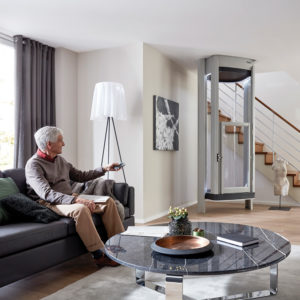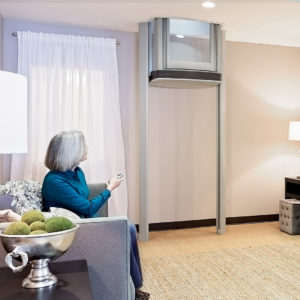Small Home Lifts Prices 2024:
How Much Does a Home Lift Cost in the UK?
As the specialists in everything domestic lifts, one of the questions we are asked most at Home Lift Experts is ‘how much does a home lift cost?’ Here is our helpful guide to give you an understanding of domestic lift prices, including small house lift prices, in the UK and what is involved in the installation of each one.
Home lifts are wholly invaluable to people with mobility difficulties or disabilities, but they are also increasingly being installed by homeowners wishing to future-proof their homes.
This helps make a property a safe and comfortable space for homeowners to stay in as they grow older. Whether your home lift is for a lifestyle choice now, or because moving around in the house is challenging, domestic lift costs are of course paramount as to whether you choose one now or prefer to save and install one in future.
What sort of domestic lifts are available to install in the home?
Before talking about house lift costs, it is important for customers to know the different types of home lifts that are available to them. It is also not always about the cheapest home lift available as these may not meet your requirements. Only then can you really talk about the cost of a lift in the home in context.
There are in fact, four main types of domestic lift available on the market, traction home lifts, vacuum home lifts, hydraulic, and non-hydraulic small home lifts – residential lift prices for all massively vary depending on its usage. At Home Lift Experts we find non-hydraulic small home lifts are the most popular due to the many benefits they offer over the other three types of lifts for the home being just one consideration.

Traction home lifts use cables and a counterweight to move up and down within a lift shaft. The cables need to be replaced every five years, so traction home lifts feature relatively high maintenance costs and disruption, plus the ride tends not to be so smooth.
Vacuum home lifts are powered by a system of pumps and turbines which control the air pressure above and below the cab to transport it. A vacuum above the cab pulls it upwards, while the slow release of air pressure floats the domestic lift back down which means there is no hoist or pit required.
Hydraulic home lifts need a lot of space as they work using a pump sending hydraulic fluid through to a jack which pushes the lift up and down by a piston at its base. These domestic lifts require a separate machine room, and more maintenance than any other home lift type, which adds to their overall long-term price.
Non-hydraulic home lifts have been at the heart of most of the technological advances in the industry, and therefore prove to be more popular than any of the more ‘traditional’ types of domestic lift. These small home lifts travel on self-supporting rails, powered by a very small, discreet motor contained within the lift itself, and plug straight into a normal household power socket.
There is no requirement for a lift shaft, or a pit, and they do not require a load bearing wall meaning these domestic lifts can fit neatly into many different locations in the home. Non-hydraulic lifts have an incredibly small footprint and many of have been designed to ‘disappear’ when not in the room, maximizing the living space in the home.
Prior to installation, only a little preparation work is required by a professional builder, minimising overhead home lift costs. With all these features and technical benefits, people are often surprised that to have one of these lifts in your house, home lifts prices for non-hydraulic lifts can be surprisingly affordable.

Domestic Lifts Cost: How Much Does a Through Floor Lift Cost in the UK?
There is lot to consider when looking at homelift prices. Of course, residential lift costs vary depending on the type of lift chosen, but from the start, there are a few variables to be aware of to make sure you are comparing like with like.
The standalone lift unit is the first domestic lift cost to consider, but you also need to know the price of the site preparation and installation based on your specific site survey, as some lift types require relatively expensive work.
In addition, do make sure that delivery of the unit is included as shipping costs can become extremely expensive. Finally, ensure you factor in any ongoing maintenance costs, as over their lifetime some types of lift cost more than others.
Traction Home Lift Cost
Traction lifts are typically more expensive than other types of home lift and based on a standard installation could cost between £28,000 and £33,000.
Vacuum Home Lift Cost
The costs for a vacuum lift start from around £28,000 but can be more depending on the type of installation.
Non-hydraulic Small Home Lift Cost
Non-hydraulic lifts are the most popular lifts due to the features, convenience, and value for money they offer. The top three brands requested are Stiltz Home Lifts, Lifton Home Lifts and Artico Home Lifts. Based on a standard installation, Stiltz have a starting price of £15,000, Lifton start from £17,000 and Artico from £20,000. These are of course indicative costs, subject to site survey and individual customers’ exact requirements, but do include all site preparation work and delivery costs.
Hydraulic Home Lift Cost
A basic hydraulic home lift, based on a standard installation for a standard through-floor lift is between £23,000 and £28,000.

Request a callback
As the specialists in everything domestic lifts, one of the questions we are asked most at Home Lift Experts is ‘how much does a home lift cost?’ Here is our helpful guide to give you an understanding of domestic lift prices, including small house lift prices, in the UK and what is involved in the installation of each one.
Home lifts are wholly invaluable to people with mobility difficulties or disabilities, but they are also increasingly being installed by homeowners wishing to future-proof their homes. This helps make a property a safe and comfortable space for homeowners to stay in as they grow older. Whether your home lift is for a lifestyle choice now, or because moving around in the house is challenging, domestic lift costs are of course paramount as to whether you choose one now or prefer to save and install one in future.
What sort of domestic lifts are available to install in the home?
Before talking about house lift costs, it is important for customers to know the different types of home lifts that are available to them. It is also not always about the cheapest home lift available as these may not meet your requirements. Only then can you really talk about the cost of a lift in the home in context.
There are in fact, four main types of domestic lift available on the market, traction home lifts, vacuum home lifts, hydraulic, and non-hydraulic small home lifts – residential lift prices for all massively vary depending on its usage. At Home Lift Experts we find non-hydraulic small home lifts are the most popular due to the many benefits they offer over the other three types of lifts for the home being just one consideration.
Traction home lifts use cables and a counterweight to move up and down within a lift shaft. The cables need to be replaced every five years, so traction home lifts feature relatively high maintenance costs and disruption, plus the ride tends not to be so smooth.
Vacuum home lifts are powered by a system of pumps and turbines which control the air pressure above and below the cab to transport it. A vacuum above the cab pulls it upwards, while the slow release of air pressure floats the domestic lift back down which means there is no hoist or pit required.
Hydraulic home lifts need a lot of space as they work using a pump sending hydraulic fluid through to a jack which pushes the lift up and down by a piston at its base. These domestic lifts require a separate machine room, and more maintenance than any other home lift type, which adds to their overall long-term price.
Non-hydraulic home lifts have been at the heart of most of the technological advances in the industry, and therefore prove to be more popular than any of the more ‘traditional’ types of domestic lift. These small home lifts travel on self-supporting rails, powered by a very small, discreet motor contained within the lift itself, and plug straight into a normal household power socket.
There is no requirement for a lift shaft, or a pit, and they do not require a load bearing wall meaning these domestic lifts can fit neatly into many different locations in the home. Non-hydraulic lifts have an incredibly small footprint and many of have been designed to ‘disappear’ when not in the room, maximizing the living space in the home.
Prior to installation, only a little preparation work is required by a professional builder, minimising overhead home lift costs. With all these features and technical benefits, people are often surprised that to have one of these lifts in your house, home lifts prices for non-hydraulic lifts can be surprisingly affordable.
Domestic Lifts Cost: How Much Does a Through Floor Lift Cost in the UK?
There is lot to consider when looking at homelift prices. Of course, residential lift costs vary depending on the type of lift chosen, but from the start, there are a few variables to be aware of to make sure you are comparing like with like. The standalone lift unit is the first domestic lift cost to consider, but you also need to know the price of the site preparation and installation based on your specific site survey, as some lift types require relatively expensive work. In addition, do make sure that delivery of the unit is included as shipping costs can become extremely expensive. Finally, ensure you factor in any ongoing maintenance costs, as over their lifetime some types of lift cost more than others.
Traction Home Lift Cost
Traction lifts are typically more expensive than other types of home lift and based on a standard installation could cost between £28,000 and £33,000.
Vacuum Home Lift Cost
The costs for a vacuum lift start from around £28,000 but can be more depending on the type of installation.
Hydraulic Home Lift Cost
A basic hydraulic home lift, based on a standard installation for a standard through-floor lift is between £23,000 and £28,000.
Non-hydraulic Small Home Lift Cost
Non-hydraulic lifts are the most popular lifts due to the features, convenience, and value for money they offer. The top three brands requested are Stiltz Home Lifts, Lifton Home Lifts and Artico Home Lifts. Based on a standard installation, Stiltz have a starting price of £15,000, Lifton start from £17,000 and Artico from £20,000. These are of course indicative costs, subject to site survey and individual customers’ exact requirements, but do include all site preparation work and delivery costs.

Request a callback
